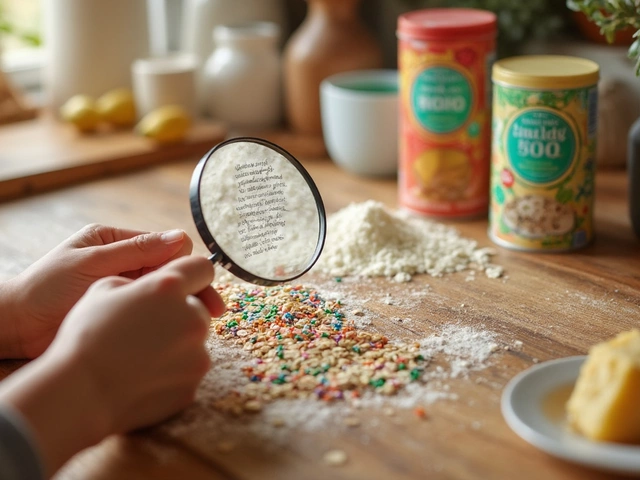
Baking vegan can feel like magic—cakes rise, cookies spread, pudding thickens—and nobody would ever guess there’s not an egg or scrap of dairy anywhere. But sometimes, it’s easy to forget the nutrients you might be missing in your desserts. Sure, that gooey brownie tastes perfect, but is it actually giving your body what it needs? Turns out, some nutrients just don’t show up as easily when animal products are out of the picture.
If you’re swapping out butter, eggs, and milk for plant-based stuff, it’s not just flavor that changes. Ever noticed how many vegan desserts rely on white flour and sugar? Tasty, yes, but those don’t exactly scream “nutrient powerhouse.” Don’t worry, you don’t have to sacrifice taste or feel guilty about indulging, but there are a few nutrition gaps you’ll want to look out for. Let’s get to the good stuff: how to fill those gaps so every bite is all pleasure, no compromise.
- Common Nutrient Gaps in Vegan Desserts
- How Vegan Sweeteners Stack Up
- Smart Flour and Fat Swaps
- Boosting Protein in Treats
- Choosing Fortified Ingredients
- Simple Tweaks for Guilt-Free Indulgence
Common Nutrient Gaps in Vegan Desserts
So, what might you be missing when you’re digging into cookies and cakes that are 100% plant-based? Vegan desserts skip dairy, eggs, and often rely on refined flour and sugar, which means some important nutrients can drop super low. It’s smart to know where those sneaky gaps show up, so your treats are satisfying without short-changing your body.
Protein usually tops the list—think about it, eggs are out, and not all plant-based swaps pack the same punch. Calcium is another biggie since there’s no milk or cream. Vitamin B12 and iron can be hard to find, too. Even healthy fats sometimes slide off the menu when you swap traditional butter for coconut oil or margarine.
| Nutrient | Why It's Lacking | Animal Source Versus Vegan Dessert |
|---|---|---|
| Protein | No eggs, no dairy | Egg: 6g/large, Almond Milk: <1g/cup |
| Calcium | Dairy is out | Milk: 300mg/cup, Oat milk: 120mg/cup |
| Vitamin B12 | Only in animal foods or fortified products | Butter: 0.2µg/tbsp, Vegan margarine: 0µg/tbsp (unless fortified) |
| Iron | Plant iron is less absorbed | Egg: 1mg/egg, Wheat flour: 0.4mg/serving |
| Omega-3s | No fish, eggs, or butter | Butter: trace, Chia/flax (if used): 2.3g/tbsp |
Here’s what you should watch out for with vegan desserts especially:
- Protein is thinner on the ground. Most go-to vegan flours don’t have much, and swapping in beans or nut butters isn’t always practical for every recipe.
- Less calcium and B12. Even plant milks don’t always match up to cow’s milk levels, unless they’re fortified (always read the label!).
- Iron’s there, but not as usable. Plant-based iron is just harder for your body to absorb unless you pair it with something rich in vitamin C (like strawberries in your shortcake—yum).
- Omega-3 fats can get weird. Unless you sneak in ground flax or chia seeds, you’re mostly getting saturated fats like coconut, which is tasty but doesn’t help your heart much.
The good news? With a few tweaks and smart swaps, you can plug those holes without turning dessert time into a science project. Next up: which sweeteners actually slip some nutrients in, and which just bring the sugar rush.
How Vegan Sweeteners Stack Up
People love sweet stuff, and vegan desserts are no different. When you drop honey from your pantry, there’s a whole world of plant-based sweeteners to pick from. But not all sweeteners are created equal, especially when we’re talking about nutrition. Let’s break down what you’re really getting with different vegan sweeteners, beyond just the taste.
Most classic vegan sweeteners—like cane sugar, maple syrup, agave, and coconut sugar—are basically empty calories. They add energy, but you won’t get much else in terms of vitamins or minerals. Some do bring a tiny bonus, though. Maple syrup and molasses offer small amounts of iron or potassium, but you’d have to eat a whole lot to actually make a difference in your diet. Not super helpful if you’re hoping your desserts will double as health foods.
If you’re watching your blood sugar, there are low-glycemic and artificial options. Stevia and monk fruit stand out since they’re natural, zero-calorie, and don’t cause a blood sugar spike. But—and here’s the catch—they don’t give you anything else, either. No protein, no vitamins, just sweetness. Coconut sugar gets hyped for having a lower glycemic index and a few minerals, but the amounts are tiny and don’t move the needle for your daily needs. Here’s a little cheat sheet comparing the most common vegan sweeteners:
| Sweetener | Main Nutrients | Calories (per tbsp) | Glycemic Index | Notes |
|---|---|---|---|---|
| Organic Cane Sugar | None | 48 | 65 | Classic for baking, no nutrients |
| Maple Syrup | Manganese, Zinc | 52 | 54 | Some minerals, but not enough to count |
| Agave Nectar | None | 60 | 15 | Low glycemic, but still high in fructose |
| Coconut Sugar | Potassium, Iron | 45 | 35 | Slightly better than white sugar, but not by much |
| Molasses | Iron, Calcium, Magnesium | 58 | 55 | Has some nutrients; strong flavor |
| Stevia | None | 0 | 0 | No calories, no blood sugar impact |
The big takeaway? None of these sweeteners will do the heavy lifting for your nutrition. Sure, a few have trace minerals, but they shouldn’t be your go-to for nutrients. When you’re making vegan desserts, it’s smarter to get creative by cutting down sugar where you can and focusing on nutritious add-ins like nuts, seeds, or even pureed beans.
- Try blending dates or ripe bananas into recipes for sweetness and extra fiber.
- Swap half the sugar for applesauce to lighten things up without losing flavor.
- If using syrups, look for those with fewer additives—and keep portions reasonable.
Sweeteners bring the fun, but when you want your treats to bring something more to the table, balance them out with ingredients that actually pull their weight in nutrition.
Smart Flour and Fat Swaps
Swapping the flour or fat in your favorite treats is where some sneaky nutrient losses show up. White flour, for example, is basically stripped of fiber and B vitamins during processing. Same goes for some neutral-tasting oils that add nothing back nutritionally. With a few clever swaps, though, you can boost both the nutrition and taste of your vegan desserts—and nobody will complain about an extra layer of flavor or chewiness.
Whole grain flours are the first upgrade. Instead of all-purpose flour, try subbing in whole wheat pastry flour, oat flour, or even spelt flour. You’ll get more fiber—meaning you’ll actually feel full after dessert, rather than just hyped up on sugar. Bonus: oatmeal cookies with real oats or oat flour have more iron, magnesium, and even some B vitamins than the average cookie. Here’s how a few options stack up nutritionally in a basic serving:
| Flour | Fiber (g) | Iron (mg) | B6 (mg) |
|---|---|---|---|
| All-Purpose | 0.8 | 0.4 | 0.02 |
| Whole Wheat | 3.0 | 0.8 | 0.05 |
| Oat Flour | 2.8 | 1.2 | 0.06 |
Ready to switch up your fats? Traditional butter isn’t an option, but you don’t have to lean on just plain oils. Nut butters, avocado, and even coconut yogurt can step in to add creaminess, healthy fats, and sometimes extra protein. Nut butters like almond or cashew also toss in vitamin E and magnesium, which is something your skin and energy levels will thank you for. Just keep an eye out for added sugars in store-bought varieties.
- Use applesauce or mashed bananas instead of oils for extra potassium and fewer calories.
- Try tahini in brownies—seriously, it makes them fudgy and adds calcium.
- Mix a bit of ground flax or chia seed into the dough for extra omega-3s and fiber.
One trick: swapping 1/3 to 1/2 of the flour in a recipe with almond meal or ground walnuts boosts both the protein and healthy fat content, turning your snack into more of a mini-meal. You won’t notice a weird aftertaste—instead, you get a richer texture and more staying power.

Boosting Protein in Treats
Here’s the thing: most vegan desserts aren’t loaded with protein. White flour, sugar, and plant-based margarines don’t exactly help you hit your daily protein target. If you’re reaching for treats on the regular, that matters—especially since protein helps with satiety and maintaining muscle, and makes your dessert more than just an empty-calorie snack.
So, what can you do to ramp up the protein in your sweets? It goes way beyond sprinkling a few nuts on top (though, hey, that's not a bad start). The trick is to sneak higher-protein ingredients right into the dough or batter. Here are some simple swaps and add-ins that work really well:
- Use beans or chickpeas: Don’t roll your eyes—white beans blend smoothly into brownies, and chickpeas make surprisingly good blondies. They add plant-based protein and a fudgy texture.
- Add vegan protein powder: Unflavored or vanilla pea, soy, or brown rice protein blends work in muffin, pancake, and cookie batters. Start slow and balance with extra liquid so things don’t get chalky.
- Try nut and seed butters: Peanut, almond, sunflower, or tahini can replace some plant butter or oil, jacking up protein and flavor for everything from cookies to bars.
- Opt for whole grain flours: Oats, spelt, and whole wheat pack a little more protein than white flour, plus more fiber.
- Stir in soy or coconut yogurt: These yogurts can add fluffiness and a protein kick to cakes and quick breads.
Want a quick cheat sheet? Check this table for approximate protein counts (per 100g) of common vegan dessert add-ins:
| Ingredient | Protein (g) |
|---|---|
| Chickpeas (cooked) | 8.9 |
| Peanut Butter | 25 |
| Almond Flour | 21 |
| Rolled Oats | 13 |
| Soy Protein Powder | 80 |
| Coconut Yogurt (unsweetened) | 1.2 |
| Soy Yogurt (unsweetened) | 4 |
If you’re baking cookies, toss in hemp or chia seeds. For cakes, sub a portion of flour for almond meal. Protein bars? Blend some tofu into the filling. The goal: make each bite count a little more, without losing that treat-yourself vibe. The best part is, you don’t even have to mention the nutrition upgrade—unless you want the bragging rights.
Choosing Fortified Ingredients
Packing your vegan desserts with nutrients is easier than you think, but only if you know where to look. Fortified ingredients are a must when you want dessert to be more than just sugar and carbs. "Fortified" just means plenty of brands add back vitamins and minerals that you’d normally find in animal products or that get stripped away during processing.
One big area to watch is plant milks. Most brands fortify their almond, soy, or oat milks with calcium, vitamin D, and even vitamin B12. These nutrients are key for bone health and nerves, and in a vegan diet, they're often in short supply. Always check the label, though—different brands can have big differences in what they add.
| Fortified Nutrient | Plant Milk Average (per cup) | Trimmed Daily Value for Adults |
|---|---|---|
| Calcium | 300 mg | 1,000 mg |
| Vitamin B12 | 1.2 mcg | 2.4 mcg |
| Vitamin D | 2.5 mcg (100 IU) | 15 mcg (600 IU) |
Flours can also be fortified, especially those made for baking. In the U.S. and U.K., white flour is usually enriched with iron and B vitamins by law. But if you’re using gluten-free or specialty flours (like almond, coconut, or oat), check out the packaging—some have extra vitamins, some don’t.
Looking to up your omega-3 game? A lot of vegan margarines and spreads are fortified with ALA, an omega-3 fatty acid. Even some chocolate chips now come with added calcium or iron. It pays to flip products over and actually read the fine print.
Wondering if this stuff really matters? Here’s what the Academy of Nutrition and Dietetics suggests:
"Vegans should regularly consume reliable sources of vitamin B12, such as fortified foods … to meet daily needs."
If you want to keep it simple, here’s what to look for on your vegan dessert shopping trip:
- Plant milk with added calcium, vitamin D, and B12
- Fortified unsweetened cocoa powder or protein powders for baking
- Enriched flour if you’re using white flour
- Vegan butters and margarines that have vitamins A and D added
- Ready-made vegan chocolate or sprinkles that mention "fortified" on their labels
It only takes a few swaps and you’re making desserts that taste incredible and actually fill some of those hidden gaps you might not even realize you had. My tip? Keep a couple of go-to fortified options in your kitchen—your future self will thank you. And hey, check labels—just because a product’s plant-based doesn’t mean it covers all your bases.
Simple Tweaks for Guilt-Free Indulgence
If vegan desserts are your thing, it’s easier than you think to level up the nutrition without killing the fun. Most of the little upgrades don’t require much extra work—just a swap here or an add-in there. And you totally deserve treats that do more than just taste good!
First up, vegan desserts are much more satisfying with some fiber, plus it keeps you feeling full. A super-easy swap: toss in a spoonful of chia seeds, flaxseed meal, or even some oats. If you’re baking brownies or muffins, replacing half the white flour with whole wheat or oat flour works wonders.
- Oat flour: Adds fiber and iron, and you barely taste the difference.
- Ground flax or chia: Brings omega-3s and fiber. Sprinkle in a tablespoon per cup of flour for most recipes.
- Fortified plant milk: Switch out water or non-fortified options with soy or oat milk that has added B12 and calcium.
Protein is another part that’s easy to overlook. Try this: add a scoop of unflavored or vanilla plant protein powder to cookies and pancakes. Or fold in chopped nuts or hemp seeds—which give a lot of crunch and protein. Win-win.
One more game-changer: swap some sugar for fruit. Mashed bananas, unsweetened applesauce, or dates can replace part of the sugar and add bonus vitamins and minerals (and moistness). In a lot of cases, you won’t notice any difference except, well, fewer sugar crashes.
Check out this cheat-sheet of simple swaps and the nutrients you gain:
| Swap/Add-In | Main Nutrient Boost | Best For |
|---|---|---|
| Oat flour | Fiber, Iron | Cookies, Muffins |
| Ground flaxseed | Omega-3, Fiber | Brownies, Pancakes |
| Fortified soy milk | B12, Calcium, Protein | Puddings, Cakes |
| Mashed banana | Potassium, Vitamin B6 | Quick breads, Pancakes |
| Chopped walnuts | Protein, Healthy fats | Brownies, Muffins |
And don’t forget, even small changes build up. If you try one or two of these, you’ll notice your desserts feel a lot more satisfying. Plus, there’s less chance you’ll have those late-night snack regrets. Whiskers, my cat, doesn’t get people food, but if he did, I’d definitely share the banana bread (minus the chocolate, of course!).





